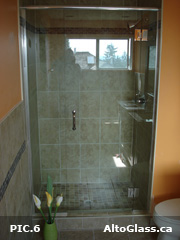Frequently Asked Questions
We use 10mm (3/8’’) - 12mm (1/2’’) tempered glass that is 6 times stronger a regular glass. For safety reasons, when broken , it shatters into small fragments.
There are two basic installation techniques:
- U-channel installation (pic. 7) U-channels are attached to the tile. Glass panels are inserted into the U-channel. Advantages:
- Cost effective.
- Strong construction.
- Clamp installation Glass panels are attached to the wall with clamps (pic. 8) Advantages:
- The frameless outward appearance.
- The 1/16’’ gap between the panel and wall doesn’t require silicon joint.
- Ease of cleaning.
 We recommend a header application (pic. 6) if:
We recommend a header application (pic. 6) if:
- There is no way to hinge off the door of the wall. (The wall is not straight; no wood studs are behind the wall in the middle of curb, etc.)
- You hinge off the door of the glass panel and the panel doesn’t go all the way to the ceiling.
- The fixed panel has a width of more than 30” (inline shower enclosure).
 A fiberglass shower base doesn’t have enough slope for eliminating water leakages on its own. We offer two possible solutions:
A fiberglass shower base doesn’t have enough slope for eliminating water leakages on its own. We offer two possible solutions:
- Threshold. See photo (pic. 2). Neo-angle shower enclosure is equipped with a threshold (pic. 3).
- Vinyl wiper. (pic. 4). Shower door is equipped with a clear vinyl wiper (pic. 5).
The slope of the curb is very important for the elimination of water. No thresholds or vinyl wipers are required if the curb has a slope 1/4’’-1/2’’. The gap between the door and top of the curb can be built up 1/8’’, which prevents water leakage.








